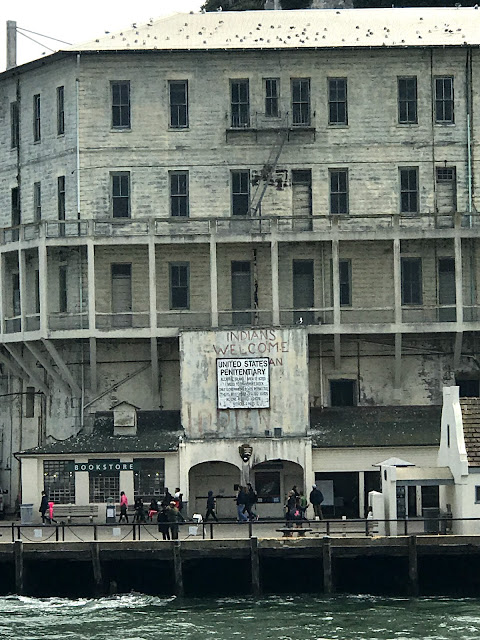Cruising around Alcatraz
I've visited San Francisco several times already but I've never ventured out onto the Bay or stepped onto the infamous Alcatraz. For one, the San Francisco Bay is known for its strong currents. Also, I've always been wary of the sharks that reportedly lurk in its murky waters (I have no plans of becoming shark bait, ever).
But really, I had all these excuses because I couldn't get hold of tickets for the Alcatraz tour... buying tickets are done way in advance and I normally decide that I'd like to visit the island just a few days before I actually go to the City. Anyway, I found an opportunity to cruise around Alcatraz and listen to its history through the Go City Card (it has an Explorer Pass option which allows you to choose what you like among a number of tourist spots). I picked the Blue and Gold Alcatraz cruise, which went under the Golden Gate Bridge and around Alcatraz Island.
I found Alcatraz's story to be rather fascinating.
Alcatraz Island was named after the birds that reside there. In Spanish, "alcatraz" means pelican. However, I didn't observe pelicans; instead, I saw a lot of gulls... I'm not sure what the black birds were though. What I do know now is why this island is also called The Rock: one side of the island is rock solid. That's where many of the birds I observed were roosting.
On top of the rocky surface, the buildings–rather, the ruins–of the penitentiary could easily be seen. The lighthouse that towers over the island is said to be the oldest lighthouse in the West Coast. Adjacent to it is the main cellhouse, where the inmates resided. Al Capone is one of its more famous jail birds.
Further down the slope, the tour guide drew our attention to a grey building assigned for workshops for inmates. It is called Model Industries Building.
This is the water tower where the island's supply of fresh water was stored. I could just imagine how difficult it was for the jail wardens to keep all the prisoners hydrated while water was being delivered from the mainland by boat. In front of the water tower is a white building with "Indian Land" written in big letters. I was trying to recall world history because I have never heard of Indians being on Alcatraz Island. Then the tour narration stated that after Alcatraz was closed down as a penitentiary, American Indians occupied the island in a bid to reclaim areas that their ancestors used to live in. Their occupation was forcibly ended by the US government a few months in... that is, these American Indians were the only occupants of Alcatraz that were unwilling to leave the place. All others wanted to escape.
Close to the water tower were the ruins of the Social Hall. It had facilities that the employees of the penitentiary could use to relax with their families.
Close to the water tower were the ruins of the Social Hall. It had facilities that the employees of the penitentiary could use to relax with their families.
During the American Indian Movement occupation, this hall was burned down, leaving nothing but the external structure. The Hoe House, where the jail wardens used to reside, also did not escape the fire associated with the occupation. Legend has it that this building is haunted. It's difficult to disagree, seeing the state of disrepair the building is currently in. I think that this is an effective means to keep people from squatting there; nobody I know would choose to live inside a haunted building.
If I'm not mistaken, this church-looking building used to be the the residential hall of the unmarried penitentiary officers. It reminded me of the architecture of the missions I've visited so far. And by the looks of it, it seems to be in good condition too. Maybe some wear and tear thanks to the constant exposure to saltwater and the biting winds of the bay.
Building 64 then came into view. It used to be an apartment building for military personnel and their families. In front of it is a watch tower. I suppose that back in the day, guards were stationed here to make sure that prisoners won't be able to swim off the island.
As the boat made a turn around the corner, I saw why this building was unique. The American Indians who occupied Alcatraz vandalised the prison sign. The people who manage Alcatraz now appears to have opted to keep the graffiti in place... probably because it's part of the island's history.
As the boat made its way back to shore, I wasn't thinking much about the grim history and the notoriety of the island. I was thinking about the film The Rock, which starred Nicholas Cage and Sean Connery. I was wondering if they actually filmed the movie there, on location.








Comments
Post a Comment
Thank you for dropping by!
Before moving on, please share your thoughts or comments about the post. :)
Thanks again!